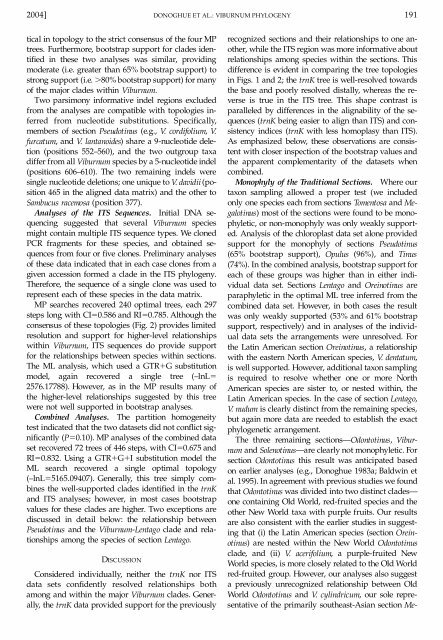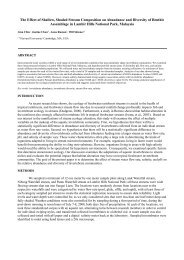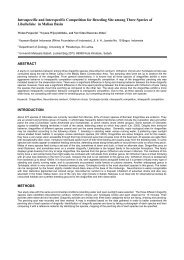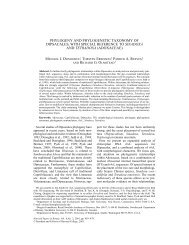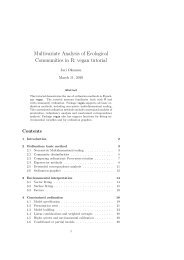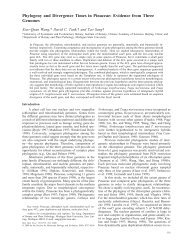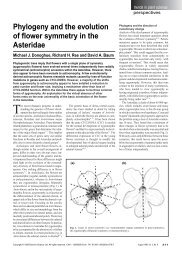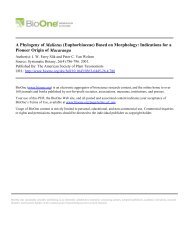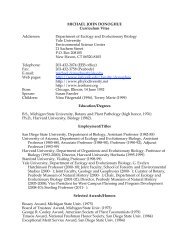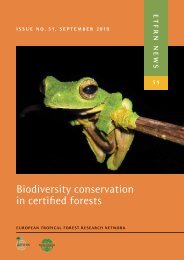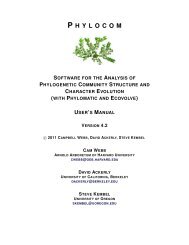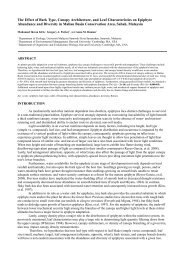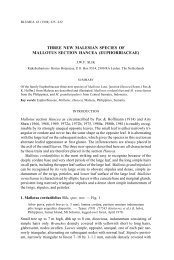Viburnum Phylogeny Based on Chloroplast trnK Intron and Nuclear ...
Viburnum Phylogeny Based on Chloroplast trnK Intron and Nuclear ...
Viburnum Phylogeny Based on Chloroplast trnK Intron and Nuclear ...
You also want an ePaper? Increase the reach of your titles
YUMPU automatically turns print PDFs into web optimized ePapers that Google loves.
2004] DONOGHUE ET AL.: VIBURNUM PHYLOGENY<br />
191<br />
tical in topology to the strict c<strong>on</strong>sensus of the four MP<br />
trees. Furthermore, bootstrap support for clades identied<br />
in these two analyses was similar, providing<br />
moderate (i.e. greater than 65% bootstrap support) to<br />
str<strong>on</strong>g support (i.e. .80% bootstrap support) for many<br />
of the major clades within <str<strong>on</strong>g>Viburnum</str<strong>on</strong>g>.<br />
Two parsim<strong>on</strong>y informative indel regi<strong>on</strong>s excluded<br />
from the analyses are compatible with topologies inferred<br />
from nucleotide substituti<strong>on</strong>s. Specically,<br />
members of secti<strong>on</strong> Pseudotinus (e.g., V. cordifolium, V.<br />
furcatum, <strong>and</strong> V. lantanoides) share a 9-nucleotide deleti<strong>on</strong><br />
(positi<strong>on</strong>s 552–560), <strong>and</strong> the two outgroup taxa<br />
differ from all <str<strong>on</strong>g>Viburnum</str<strong>on</strong>g> species by a 5-nucleotide indel<br />
(positi<strong>on</strong>s 606–610). The two remaining indels were<br />
single nucleotide deleti<strong>on</strong>s; <strong>on</strong>e unique to V. davidii (positi<strong>on</strong><br />
465 in the aligned data matrix) <strong>and</strong> the other to<br />
Sambucus racemosa (positi<strong>on</strong> 377).<br />
Analyses of the ITS Sequences. Initial DNA sequencing<br />
suggested that several <str<strong>on</strong>g>Viburnum</str<strong>on</strong>g> species<br />
might c<strong>on</strong>tain multiple ITS sequence types. We cl<strong>on</strong>ed<br />
PCR fragments for these species, <strong>and</strong> obtained sequences<br />
from four or ve cl<strong>on</strong>es. Preliminary analyses<br />
of these data indicated that in each case cl<strong>on</strong>es from a<br />
given accessi<strong>on</strong> formed a clade in the ITS phylogeny.<br />
Therefore, the sequence of a single cl<strong>on</strong>e was used to<br />
represent each of these species in the data matrix.<br />
MP searches recovered 240 optimal trees, each 297<br />
steps l<strong>on</strong>g with CI50.586 <strong>and</strong> RI50.785. Although the<br />
c<strong>on</strong>sensus of these topologies (Fig. 2) provides limited<br />
resoluti<strong>on</strong> <strong>and</strong> support for higher-level relati<strong>on</strong>ships<br />
within <str<strong>on</strong>g>Viburnum</str<strong>on</strong>g>, ITS sequences do provide support<br />
for the relati<strong>on</strong>ships between species within secti<strong>on</strong>s.<br />
The ML analysis, which used a GTR1G substituti<strong>on</strong><br />
model, again recovered a single tree (–lnL5<br />
2576.17788). However, as in the MP results many of<br />
the higher-level relati<strong>on</strong>ships suggested by this tree<br />
were not well supported in bootstrap analyses.<br />
Combined Analyses. The partiti<strong>on</strong> homogeneity<br />
test indicated that the two datasets did not c<strong>on</strong>ict signicantly<br />
(P50.10). MP analyses of the combined data<br />
set recovered 72 trees of 446 steps, with CI50.675 <strong>and</strong><br />
RI50.832. Using a GTR1G1I substituti<strong>on</strong> model the<br />
ML search recovered a single optimal topology<br />
(–lnL55165.09407). Generally, this tree simply combines<br />
the well-supported clades identied in the <strong>trnK</strong><br />
<strong>and</strong> ITS analyses; however, in most cases bootstrap<br />
values for these clades are higher. Two excepti<strong>on</strong>s are<br />
discussed in detail below: the relati<strong>on</strong>ship between<br />
Pseudotinus <strong>and</strong> the <str<strong>on</strong>g>Viburnum</str<strong>on</strong>g>-Lentago clade <strong>and</strong> relati<strong>on</strong>ships<br />
am<strong>on</strong>g the species of secti<strong>on</strong> Lentago.<br />
DISCUSSION<br />
C<strong>on</strong>sidered individually, neither the <strong>trnK</strong> nor ITS<br />
data sets c<strong>on</strong>dently resolved relati<strong>on</strong>ships both<br />
am<strong>on</strong>g <strong>and</strong> within the major <str<strong>on</strong>g>Viburnum</str<strong>on</strong>g> clades. Generally,<br />
the <strong>trnK</strong> data provided support for the previously<br />
recognized secti<strong>on</strong>s <strong>and</strong> their relati<strong>on</strong>ships to <strong>on</strong>e another,<br />
while the ITS regi<strong>on</strong> was more informative about<br />
relati<strong>on</strong>ships am<strong>on</strong>g species within the secti<strong>on</strong>s. This<br />
difference is evident in comparing the tree topologies<br />
in Figs. 1 <strong>and</strong> 2; the <strong>trnK</strong> tree is well-resolved towards<br />
the base <strong>and</strong> poorly resolved distally, whereas the reverse<br />
is true in the ITS tree. This shape c<strong>on</strong>trast is<br />
paralleled by differences in the alignability of the sequences<br />
(<strong>trnK</strong> being easier to align than ITS) <strong>and</strong> c<strong>on</strong>sistency<br />
indices (<strong>trnK</strong> with less homoplasy than ITS).<br />
As emphasized below, these observati<strong>on</strong>s are c<strong>on</strong>sistent<br />
with closer inspecti<strong>on</strong> of the bootstrap values <strong>and</strong><br />
the apparent complementarity of the datasets when<br />
combined.<br />
M<strong>on</strong>ophyly of the Traditi<strong>on</strong>al Secti<strong>on</strong>s. Where our<br />
tax<strong>on</strong> sampling allowed a proper test (we included<br />
<strong>on</strong>ly <strong>on</strong>e species each from secti<strong>on</strong>s Tomentosa <strong>and</strong> Megalotinus)<br />
most of the secti<strong>on</strong>s were found to be m<strong>on</strong>ophyletic,<br />
or n<strong>on</strong>-m<strong>on</strong>ophyly was <strong>on</strong>ly weakly supported.<br />
Analysis of the chloroplast data set al<strong>on</strong>e provided<br />
support for the m<strong>on</strong>ophyly of secti<strong>on</strong>s Pseudotinus<br />
(65% bootstrap support), Opulus (96%), <strong>and</strong> Tinus<br />
(74%). In the combined analysis, bootstrap support for<br />
each of these groups was higher than in either individual<br />
data set. Secti<strong>on</strong>s Lentago <strong>and</strong> Oreinotinus are<br />
paraphyletic in the optimal ML tree inferred from the<br />
combined data set. However, in both cases the result<br />
was <strong>on</strong>ly weakly supported (53% <strong>and</strong> 61% bootstrap<br />
support, respectively) <strong>and</strong> in analyses of the individual<br />
data sets the arrangements were unresolved. For<br />
the Latin American secti<strong>on</strong> Oreinotinus, a relati<strong>on</strong>ship<br />
with the eastern North American species, V. dentatum,<br />
is well supported. However, additi<strong>on</strong>al tax<strong>on</strong> sampling<br />
is required to resolve whether <strong>on</strong>e or more North<br />
American species are sister to, or nested within, the<br />
Latin American species. In the case of secti<strong>on</strong> Lentago,<br />
V. nudum is clearly distinct from the remaining species,<br />
but again more data are needed to establish the exact<br />
phylogenetic arrangement.<br />
The three remaining secti<strong>on</strong>s—Od<strong>on</strong>totinus, <str<strong>on</strong>g>Viburnum</str<strong>on</strong>g><br />
<strong>and</strong> Solenotinus—are clearly not m<strong>on</strong>ophyletic. For<br />
secti<strong>on</strong> Od<strong>on</strong>totinus this result was anticipated based<br />
<strong>on</strong> earlier analyses (e.g., D<strong>on</strong>oghue 1983a; Baldwin et<br />
al. 1995). In agreement with previous studies we found<br />
that Od<strong>on</strong>totinus was divided into two distinct clades—<br />
<strong>on</strong>e c<strong>on</strong>taining Old World, red-fruited species <strong>and</strong> the<br />
other New World taxa with purple fruits. Our results<br />
are also c<strong>on</strong>sistent with the earlier studies in suggesting<br />
that (i) the Latin American species (secti<strong>on</strong> Oreinotinus)<br />
are nested within the New World Od<strong>on</strong>totinus<br />
clade, <strong>and</strong> (ii) V. acerifolium, a purple-fruited New<br />
World species, is more closely related to the Old World<br />
red-fruited group. However, our analyses also suggest<br />
a previously unrecognized relati<strong>on</strong>ship between Old<br />
World Od<strong>on</strong>totinus <strong>and</strong> V. cylindricum, our sole representative<br />
of the primarily southeast-Asian secti<strong>on</strong> Me-


